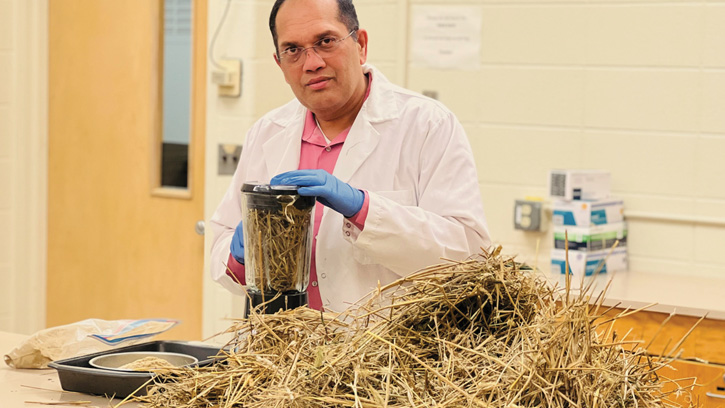From Field to Film
Profile | RESEARCH
Plastic waste is found everywhere from the Arctic to our blood systems, and it’s not going anywhere anytime soon. That’s because, depending on the plastic, it takes hundreds of years for it to break down—some estimates say 1,000 years. “During the process, a lot of damage is being done to the environment,” says Srinivas Janaswamy, associate professor of dairy and food science at South Dakota State University.
Janaswamy’s background in physics and his research into three-dimensional structures of carbohydrates and starch triggered his interest in finding a material to replace packaging plastics. The idea behind Janaswamy’s current approach traces back to 2016 when he made films from cellulose powder with a collaborator at the U.S. Department of Agriculture (USDA) who was working on cellulose extraction.
He’s now leading a team of researchers that recently received a $480,000 USDA grant. They’re hoping to solve two problems with one product by creating a strong, sustainable, and flexible packaging film that biodegrades quickly and is made from agricultural biomass.
Film From Cellulose
The agricultural products (biomass) they’re using are usually left on the field after harvest or used as animal feed; others are native grasses. Those include corn stover, wheat straw, oat straw, soybean biomass, switchgrass, and prairie cordgrass.
The researchers grind the biomass into a powder, extract the cellulose, and then solubilize it using an organic salt like zinc chloride. The solution is strengthened by calcium chloride. What they get is a transparent film.
In the laboratory, they get about one pound of cellulose out of three pounds of biomass. The yield varies depending on the kind of biomass used because each contains different amounts of cellulose, Janaswamy notes. This means the final film will be slightly different depending on the biomass used. In commercial production, he anticipates that the ratio could change as well.
The researchers are working on assessing the base materials’ differences. “The goal here is first to understand how the corn stover is going to be different from the soy or wheat or switchgrass or prairie grass because the cellulose fraction is different,” he says.
While Janaswamy and his team are certainly not the only ones working on sustainable packaging, the researcher says that this project differs from others because the agricultural biomass itself is a very environmentally sustainable source of cellulose. Other sources, like trees, also contain cellulose but are better used to store carbon, he explains.
“Every year, we produce lots and lots of biomass, and that’s left in the field. That improves the soil health, and also, we use it as a cattle feed,” says Janaswamy, noting that both uses are important. “But if we could use a fraction of [the biomass] and extract the cellulose, I believe that would help us to address this plastic problem.”
Benefits for Farmers
This research is a sound idea that could offer the additional benefit of providing a reliable source of supplementary income for farmers, says Kasiviswanathan Muthukumarappan, distinguished professor in South Dakota State University’s Agricultural and Biosystems Engineering Department, who is not involved with this research. “It will be a very good value-added revenue for the farmers if this project becomes more practical commercially,” he says.
While Janaswamy is happy with the film the team has developed, the researchers continue to work on making it stronger and more flexible. Janaswamy is also striving to retain some of the biomass’s other biopolymers, like lignin and hemicellulose. “That would further enhance the strength of the films that we make,” he says.
Janaswamy sees the potential for this process to be scaled to industrial levels for commercial production. Industry is looking for sustainable packaging, he says, so his team is conducting a life cycle assessment and economic analysis of their waste-to-film process to better understand the project’s commercial viability.
“Most importantly, I sincerely believe this solves a lot of problems that we are facing at this moment,” he says. “Hopefully, the plastic pollution will be addressed, but it will take time because we’ve already done a lot of harm to the environment.”
Vital Statistics
Credentials: PhD, Crystallography, Indian Institute of Technology; MS, Physics and Education, Regional College of Education (NCERT); BS, Physics, Mathematics, and Electronics, Nagarjuna University
Recognition: 2022 David Fee Memorial Lecture Award at South Dakota State University
LinkedIn: linkedin.com/in/janaswamy/


